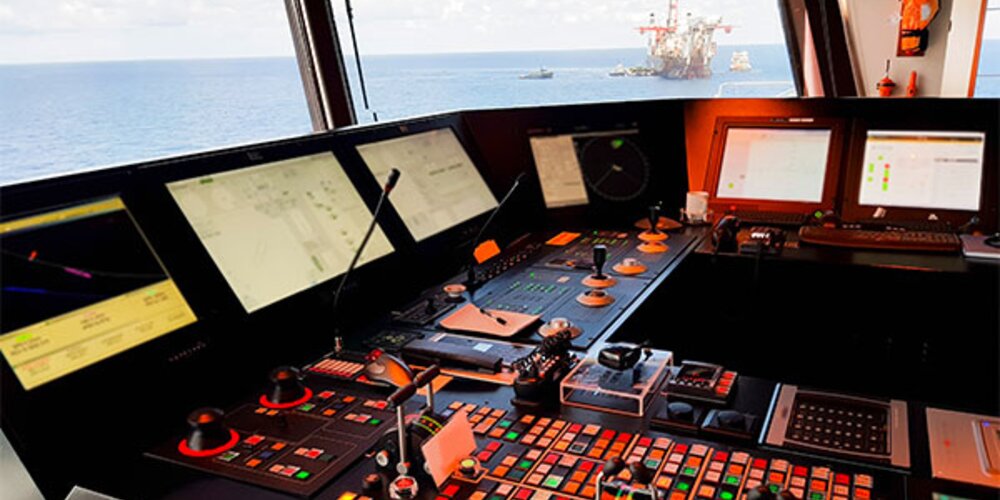Browse our services
Explore how Brookes Bell can help you
Find an expert
Meet our team, find and expert and connect
Contact us
Get in touch, we're here to help

Dynamic Positioning (DP) systems are a critical piece of marine technology for semi-submersible drilling rigs, ensuring precise positioning during offshore drilling operations. However, the biggest threat to the profitability of these offshore operations is downtime, which must be reduced as much as feasibly possible to improve commercial success.
Recent concerns and past incidents have highlighted potential risks associated with these systems, including the susceptibility to human error, its technical reliability and its responses to severe weather conditions. Understanding the risks involved and addressing them appropriately will help maintain crucial operational safety, ensure economic viability and minimise potential impact to the marine environment.
With the complexity of DP systems and its accompanying machinery, possible disconnections, or damage to the well itself, can have significant financial implications for rig operators.
“This is where rigs have the greatest risk to profitability. Offshore installations like these have to run 24 hours a day so the real challenge for rigs is keeping everything running, as downtime is very expensive for Operators,” said Erik Oberlin, Managing Master Mariner at Brookes Bell. Downtime from drilling operations can cause costs to quickly escalate into hundreds of thousands of dollars, or even into the millions through lost revenue, not to mention potential disputes between the vessel Owners and its Operators over who is at fault. While DP systems are generally considered to be accurate and reliable, incidents do happen. According to the International Marine Contractors Association (IMCA), the majority of incidents relating to DP position loss point to human error as the greatest risk factor. This is reiterated by the National Offshore Petroleum Safety and Environmental Management Authority (NOPSEMA), which raised concerns about the DP system’s vulnerability to human error accidents.
Costly Issues
In the past few years, several incidents have occurred where the DP system was accidentally disengaged causing the vessel to lose position. In the UK in 2016, the accidental disengagement of the DP system led to shearing of the drill pipe and disengaging the lower marine riser package (LMRP). This was exacerbated by a delayed crew response in understanding that the DP was disengaged and the “poor ergonomic design of the control system”, according to the UK’s Health and Safety Executive, with NOPSEMA encouraging facility operators to assess the susceptibility of design-induced human error within DP control rooms.
This isn’t to say that technological and reliability issues are not a threat to operations. Erik reiterated that the complexity of systems and offshore rigs can lead to expensive problems.
“There is so much equipment on board and no way technicians can be experts in everything. The DP equipment is super sophisticated, while there is also the thrusting equipment and power management aspect of the vessel. There’s a lot that could possibly go wrong and small problems can become big very quickly if you do not have the right experts on board that know how to mitigate these risks,” he noted.
“Modern drilling rigs rely on an incredible amount of technological systems, from navigation to DP equipment and if these go down and things get ugly, it could cost millions to remedy that,” Erik added.
Whereas previously, drive-offs, drift-offs and position loss due to technological issues were a significant issue with DP systems, advancements mean they are becoming less vulnerable. This was largely the case whereby DP systems had little built-in redundancy, potentially causing delays in order to fix any issues.
Newer systems, on the other hand, reduce vulnerability through multiple or triple redundancy measures. Due to the constant upgrading of technology towards newer, more sophisticated DP systems, the prevalence of reliability issues continues to decrease, with points to failures linked to peripheral equipment such as thruster dropout and failure, or human intervention, including the non-adherence to correct operational guidelines.
Although the risks of DP for semi-submersibles are noteworthy and should be taken seriously, there are advantages to its alternatives such as mooring. For instance, mooring includes lengthy, time-consuming disconnection procedures that must be undertaken when facing severe weather conditions that cannot be endured. While DP vessels offer flexibility by relocating to safer waters or ports, this still presents a disruption to drilling operations.
At the Forefront
The complexity surrounding offshore rigs and their various mechanical components, from sub-sea operations to drilling to basic vessel management, means that Brookes Bell has had to develop the necessary expertise to support vessel Owners, Managers and Operators when it comes to the offshore sector. This means offering support in areas including Marine Engineering, Master Mariner services, Cargo Scientists, personal injury and fire response specialists and more.
“These vessels are major investments, sometimes costing up to $500 million each and the operational costs are staggering. Offshore rigs in the oil and gas sector are likely to still be a crucial part of our energy output, at least for the next two decades and it is hazardous work. All of this means Owners and Operators need to know they have the resources available at Brookes Bell to assist with all manner of maintenance issues and personal injury claims,” Erik noted.